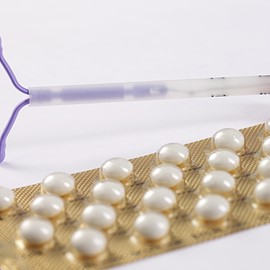There are many types of contraception available in the UK, and choosing which to use can be difficult. Always speak to a trained medical professional before starting a new contraception - they can advise you if anything in your medical history should affect your decision. We recommend trying your pharmacist first, but you may need to see a doctor or family planning nurse too.
Not sure what to expect? Our checklist can help prepare you.
Remember, the effectiveness of any contraception is based on correct usage as outlined in the patient information leaflet. If you don’t use it as often as you should, or you use it incorrectly, you may not have full protection against pregnancy. If you think you might need emergency contraception, consult a pharmacist as soon as possible.
Which contraception is right for me?
Combined pill
Who is it suited for?
The combined pill may be suitable for women of child-bearing age up until menopause, as long as there are no medical reasons as outlined in the patient information leaflet.
The combined pill might be suited to groups including but not limited to:
- New mothers who aren’t breastfeeding
- Non-smokers
The combined pill contains two female sex hormones, oestrogen and progestogen. The pill works to prevent conception by stopping ovulation, blocking sperm from reaching released eggs, and thinning the womb lining so fertilised eggs are less likely to implant. It is also a less invasive form of contraception than methods such as implants.
However, the combined pill doesn’t offer protection against sexually transmitted infections (STIs). It can have some side effects such as headaches, breast tenderness, nausea and mood swings.
Progestogen-only pill (POP or mini pill)
Who is it suited for?
The progestogen-only pill may be suitable for women of child-bearing age up until menopause, as long as there are no medical reasons as outlined in the patient information leaflet.
The progestogen-only pill might be suited to groups including but not limited to:
- Breastfeeding mothers
- Those who cannot take oestrogen
- Women who smoke
The progestogen-only pill (POP), as the name suggests, contains progestogen and not oestrogen. It works by thickening the cervical mucus to stop sperm reaching and fertilising eggs. The desogestrel mini pill can also prevent ovulation. Lovima® is a desogestrel POP.
Since it doesn’t contain oestrogen, the POP is appropriate for those who cannot take the hormone - including new mothers who wish to breastfeed. Like the combined pill, it is less invasive than methods such as implants.
However, you may not be able to take the POP if you have a history of certain medical conditions, or are taking certain medications. The mini pill might also make your periods less regular, less frequent, or even stop your periods altogether. As with the combined pill, the POP does not protect you against STIs.
Condoms
Who is it suited for?
Groups including, but not limited to:
- Those who want protection from STIs
- Those who find it difficult to remember to take a pill at the same time every day
- Those who want hormone-free contraception
Condoms are barrier contraceptives - they physically block sperm from touching a sexual partner’s genitals. There are two types of condoms: external, which are worn on the penis; and internal, which are worn inside the vagina.
Condoms give protection against STIs such as HIV, chlamydia, and gonorrhoea. You only need to use condoms when you have sex, and if you’ve already got some, then you don’t need to plan ahead. Putting a condom on can be an enjoyable aspect of sex, with a variety of shapes, sizes, and flavours available.
In some cases, however, latex condoms can cause allergic reactions (although you can get condoms made out of polyurethane instead). Also, oil-based lubricants and spermicides shouldn’t be used in conjunction with condoms, as they can weaken the material and make them more likely to split.
IUD
Who is it suited for?
Groups including, but not limited to:
- Those who want contraception they don’t have to keep reapplying in the short term
- Those who cannot take oestrogen
- Breastfeeding mothers
An intrauterine device (IUD) is a small copper and plastic instrument that is inserted into the womb by a doctor or a nurse. It then releases copper into your body which alters the cervical mucus to prevent sperm from fertilising eggs. Depending on the type you get, an IUD can prevent pregnancy for five to 10 years. It is sometimes referred to as the ‘coil’.
IUDs are suitable for the vast majority of women, and because they last so long, they’re popular with those who don’t want to have to remember to take a pill every day, or reapply a patch or injection. You can get pregnant immediately after the IUD is removed and take other medications while using it. It’s also suitable for breastfeeding mothers.
Sometimes, IUD is also used to refer to an intrauterine system (IUS) , which lasts between three and five years and uses the hormone progestogen to protect against pregnancy. This does not involve oestrogen, and can be used while breastfeeding. You can try to conceive as soon as the IUS is removed.
It’s important to remember that IUDs don’t protect against STIs, so you may wish to use condoms as well. Some people suffer from heavier, longer, or more painful periods after an IUD is fitted, but this may ease after a few months. There is a very small risk you may get a pelvic infection in the first 20 days after the IUD is inserted.
Injection
Who is it suited for?
Groups including, but not limited to:
- Those who don’t want to have to remember to use contraception every day
- Those who cannot take oestrogen
- Those who don’t wish to conceive in the near future
The contraceptive injection uses progestogen to prevent pregnancy by thickening the cervical mucus so that it’s more difficult for sperm to reach the egg. It also prevents ovulation and thins the uterine wall to reduce the likelihood of a fertilised egg implanting. Depending on which injection you get, it can last for between eight and 13 weeks.
You can use the injection if you’re breastfeeding, but you may be advised to wait until six weeks after birth. This form of contraception doesn’t require daily use unlike the pill. You can also take most other medications while using the injection - check with your pharmacist to be sure.
The injection doesn’t give protection against STIs, so you may wish to use condoms as well. You may experience side effects like headaches, nausea, heavier periods, and weight gain while using it. After you stop having the injection, it may take up to a year for your fertility to return to normal.
Patch
Who is it suited for?
Groups including, but not limited to:
- Those who don’t want to take a daily contraceptive like the pill
The contraceptive patch is a small adhesive patch that releases oestrogen and progestogen, just like the combined pill. Unlike the pill, though, the hormones bypass the stomach, so persistent vomiting and diarrhoea won’t reduce the effectiveness of your contraception. The patch is very sticky, so you can wear it underwater and while exercising without it coming off. You change it every seven days for three weeks, and then have seven days without it.
Like the pill, the patch is far less invasive than methods such as IUDs and implants. Also, you don’t have to remember it as often as the pill.
However, the patch doesn’t protect you against STIs, so you may still want to use condoms for additional protection. You may experience mild skin irritation from the adhesive, but putting the patch in a different place each time you use it may prevent this. If you find remembering to use contraceptives difficult, a longer term method like an IUD or injection may be more appropriate for you.
Implant
Who is it suited for?
Groups including, but not limited to:
- Those who don’t want to have to remember to take a daily contraceptive
- Breastfeeding mothers
- Those who cannot use oestrogen-based contraceptives
The implant is a small plastic rod inserted into the arm by a doctor or nurse. It releases progestogen into your bloodstream, and lasts for up to three years, although you can choose to have the implant removed before then.
Once you have the implant, you don’t need to worry about it until it’s time to replace it. Breastfeeding mothers can use it, and if you decide you want to try to conceive, you’ll be able to do so as soon as the implant is removed.
Like many other contraceptives, it doesn’t protect against STIs, so you may want to use condoms as well. It may also cause some temporary side effects during the first few months of use. If you’re not comfortable with the insertion procedure and using local anaesthetic, another form of contraception may be more suitable for you.
Diaphragms
Who is it suited for?
Groups including, but not limited to:
- Those who don’t want to use a daily or long term contraceptive
A diaphragm or cap is a small cup-like object that is inserted into the vagina to prevent sperm entering the womb. It is used with a gel called spermicide that is designed to kill the sperm. You must keep the diaphragm in place for at least six hours after sex, and apply extra spermicide if the diaphragm has been in position for three hours or if you want to have sex again.
Diaphragms only need to be used when you have sex, but they rely on you remembering to use them and you using them correctly. There are no known side effects of using diaphragms correctly, however leaving one in for over 30 hours or using it during your period could cause toxic shock syndrome.
Unfortunately, diaphragms aren’t quite as effective as other methods of contraception, and unlike condoms, they don’t protect against STIs. They can also take time to become comfortable using.
Making your decision
This list isn’t exhaustive, and there are other types of contraception out there that may suit your needs. Whichever method you choose, always consult a medical professional such as a pharmacist to ensure you’re making the best choice for your health.




